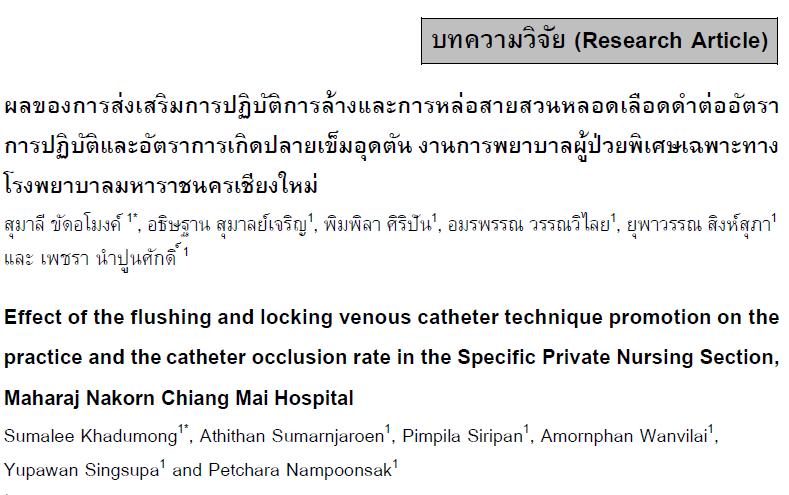Effect of the flushing and locking venous catheter technique promotion on the practice and the catheter occlusion rate in the Specific Private Nursing Section, Maharaj Nakorn Chiang Mai Hospital
Keywords:
Flushing and locking, IV care, Tip occlusionAbstract
This research is a quasi-experimental research, 1 group, pre-post measurement was to study the effects of the promotion of the flushing and locking technique with the intravenous device on the practice rate versus the catheter occlusion rate pre and post the promotion. The promotion of the intravenous flushing and locking technique was carried out in the Specific Private Nursing Section, Maharaj Nakorn Chiang Mai Hospital, from July 1st, 2021 to February 28st, 2022. The study cohort included the nurses carrying out the catheterization and the patients who underwent injection via a port intravenous catheter. The study tools were 1) a demographic recording form 2) the flushing and locking venous catheter technique promotion 3) an observation checklist form 4) a form to assess flushing and locking knowledge 5) an occlusion recording form. Occlusion 1) Rate and nursing practice pre and post the study were analyzed using the Chi-square test. 2) Nursing knowledge pre and post the promotion was analyzed using a t-test and a Wilcoxon Matched-Pairs Signed Rank Test. The results showed that the knowledge score was significantly increased (p<0.001), nursing practice significantly increased from74.66% to 95.33% (p<0.001), and the occlusion rate significantly decreased from 6.90% to 3.67% (p<0.001). Promoting the compliances of nurses with the practice of the flushing and locking technique for prevention of intravenous catheter tip occlusion reduced the occlusion rate and hence improved patient care. This study shows that multiple strategies should be employed to ensure the promotion is sustained and monitored continuously strategies supervision and monitor continuously.
References
Hadaway L. Flushing to reduce central catheter occlusions. Nursing. 2000; 30(10): 74. doi:10.1097/00152193-200030100-00037.
Gorski L, Hadaway L, Hagle M, McGoldrick M, Orr M, Doellman D. Infusion therapy standards of practice. JIN. 2016; 39(1S):159.
Infusion Nurse Network of Thailand (INNT). Nursing guidelines for patients receiving intravenous fluids.1st ed. Bangkok: Pre-one; 2018.1-50.
Ferroni A, Gaudin F, Guiffant G, et al. Pulsative flushing as a strategy to prevent bacterial colonization of vascular access devices. Med Devices (Auckl). 2014;7:379-83. Published 2014 Nov 7. doi:10.2147/MDER.S71217.
Kongvivegkhachornkij W, Pookboonmee R. A research utilization project: using evidence-based for development of clinical nursing practice guideline for prevention of blood clotting in peripheral intravenous lock in pediatric patients. Rama Nurs J. 2004;12(3):239-54.
Moureau NL. Safe patient care when using vascular access devices. Br J Nurs. 2013; 22(1): 14–21.
Bunce M. Troubleshooting central lines. RN. 2003;66(12):28-33.
Keogh S, Flynn J, Marsh N, Mihala G, Davies K, Rickard C. Varied flushing frequency and volume to prevent peripheral intravenous catheter failure: a pilot, factorial randomised controlled trial in adult medical-surgical hospital patients. Trials. 2016;17(1):348. doi:10.1186/s13063-016-1470-6.
Sona C, Prentice D, Schallom L. National survey of central venous catheter flushing in the intensive care unit. Critical Care Nurse. 2012;32(1):12–19. doi: 10.4037/ccn2012296.
The RCN IV Therapy Forum. Standards for Infusion Therapy. 3rd ed. London: Royal College of Nursing; 2010: 94s. [ISBN 978-1-906633-19-6].
Slovensky DJ, Paustian PE. Training the adult learner in health care organizations. In: Spath PL, (Eds). Guide to effective staff development in health care organizations. New York: The Jossey-Bass; 2002:100-4.
Picheansathian W, Dumrongkullachat D, Wongsaen R, Kaveevon T, Koonna A, Netsawang P. Promoting evidence-based practices among nursing the management of peripheral intravascular devices. Nursing Jurnal. 2014;41:71-87.
Prompriang P, Chitreecheur J, Boonchuang P. Effects of evidence-based practice promotion for infection prevention on knowledge and practices among nurses and incidence of peripheral intravenous infection in a community hospital. J Thai Nurse midwife Counc [Internet]. 2012 Sep. 7 [cited 2024 Feb. 19];24(3): 31. Available from:https://he02.tcithaijo.org/index.php/TJONC/article/view/2574.
Prompitakkul J, Eungaraam W, Juangpanich U, Simajareuk K, Tangtrakul S, Buranapiyawong L. Development of clinical nursing practice guideline : prevention blood clotted of intravenous peripheral normal saline lock. Journal of Nursing Science & Health. 2010;33(1):62-8.
Sripromma P, Sukthongsa D. Caring for patients with bloodstream infections from insertion of a central venous catheter: a case study. VNJ. 2019;21(2):88-98.
Hadaway, Lynn.Flushing vascular access catheters: risks for infection transmission. Infection Control Resource. 2007:1-8.
Goossens, G. A. Review Article: Flushing and locking of venous catheters: available evidence and evidence deficit. JNPR. 2015:1-12.
Zhu L, Liu H, Wang R, Yu Y, Zheng F, Yin J. Mechanism of pulsatile flushing technique for saline injection via a peripheral intravenous catheter. Clinical Biomechanics. 2020;80:1-8.

Downloads
Published
How to Cite
Issue
Section
License
Copyright (c) 2024 University of Phayao

This work is licensed under a Creative Commons Attribution-NonCommercial-NoDerivatives 4.0 International License.
ผู้นิพนธ์ต้องรับผิดชอบข้อความในบทนิพนธ์ของตน มหาวิทยาลัยพะเยาไม่จำเป็นต้องเห็นด้วยกับบทความที่ตีพิมพ์เสมอไป ผู้สนใจสามารถคัดลอก และนำไปใช้ได้ แต่จะต้องขออนุมัติเจ้าของ และได้รับการอนุมัติเป็นลายลักษณ์อักษรก่อน พร้อมกับมีการอ้างอิงและกล่าวคำขอบคุณให้ถูกต้องด้วย
The authors are themselves responsible for their contents. Signed articles may not always reflect the opinion of University of Phayao. The articles can be reproduced and reprinted, provided that permission is given by the authors and acknowledgement must be given.







